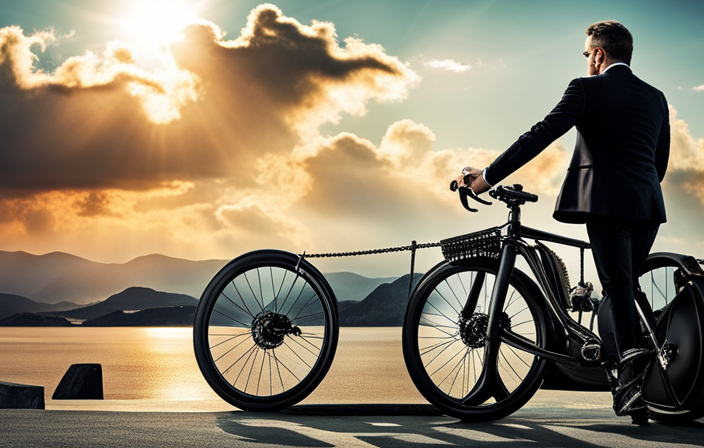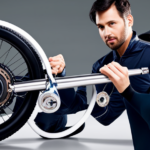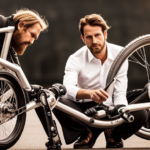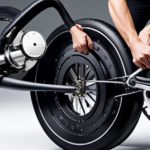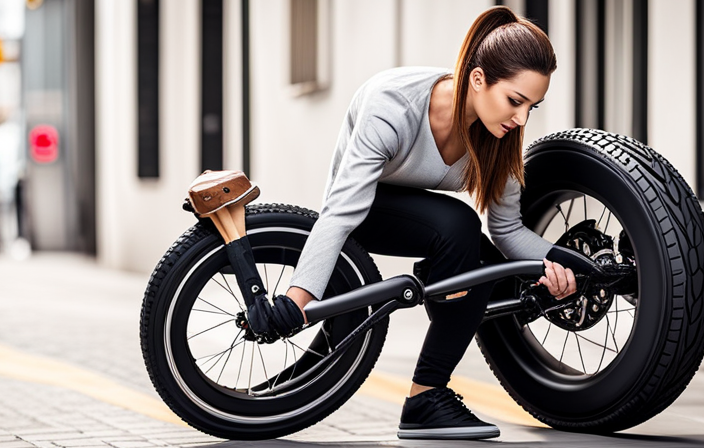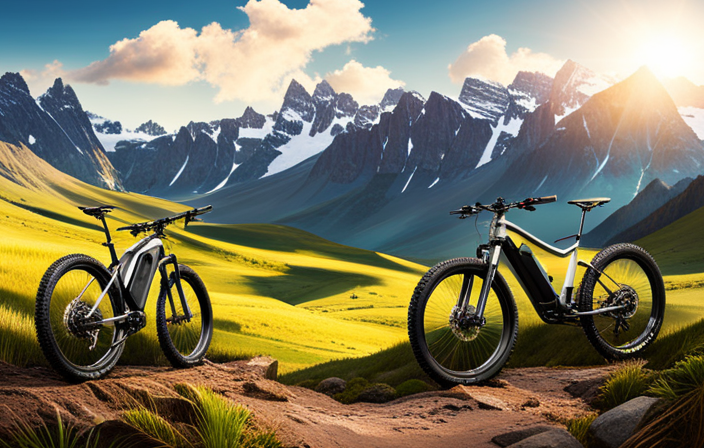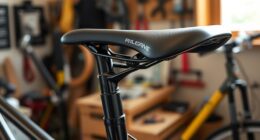Did you know that the front brushless hub motor is a crucial component of your Prodeco electric bike? If you’re experiencing issues with its performance, rest assured that troubleshooting and removing the motor is a manageable task.
In this article, I’ll guide you through the necessary steps to identify and address common problems. By following these technical instructions, you’ll be able to maintain the optimal functionality of your electric bike and get back on the road in no time.
Key Takeaways
- Disconnecting the motor from the electrical system and removing necessary components are the initial steps in the motor replacement process.
- Proper connection of color-coded wires and ensuring secure connections without debris or corrosion are crucial in motor wire connection.
- Testing the motor’s functionality, troubleshooting unusual noises, and observing motor performance are essential for identifying issues and ensuring optimal performance.
- Proper installation, regular testing, and maintenance are important for enhancing motor performance, increasing longevity, and ensuring safety and reliability during bike rides.
Identify the Issue with Your Front Brushless Hub Motor
To troubleshoot your Prodeco electric bike front brushless hub motor, you need to identify the issue first. Start by inspecting the motor for any visible damage or loose connections.
Check if the motor is making any unusual noises or if the bike is experiencing a sudden loss of power. These troubleshooting steps will help you identify common motor issues such as a faulty controller, damaged wiring, or a worn-out motor.
Once you have determined the problem, you can proceed to gather the necessary tools for removal and troubleshooting. It is important to ensure you have the appropriate tools and equipment, such as a set of Allen wrenches, a multimeter, and a repair manual specific to your Prodeco electric bike model.
Gather the Necessary Tools for Removal and Troubleshooting
First, make sure you have all the tools needed for the job. When troubleshooting an electric bike motor, having the right tools is essential. Here is a list of the necessary tools for removing and troubleshooting a Prodeco electric bike front brushless hub motor:
| Tools Needed | Purpose |
|---|---|
| Allen wrench set | To remove screws and bolts |
| Multimeter | To test electrical connections and diagnose issues |
| Torque wrench | To tighten bolts to the correct specifications |
| Wire cutters/strippers | To cut and strip wires for testing or replacement |
Having these tools on hand will make the removal and troubleshooting process much smoother. Once you have gathered all the necessary tools, you can proceed to the next step of disconnecting the motor from the electrical system.
Transition: Now that we have all the tools ready, we can move on to disconnecting the motor from the electrical system.
Disconnect the Motor from the Electrical System
Next, you’ll need to disconnect the motor from the electrical system. This step is crucial in troubleshooting and performing motor maintenance. To properly disconnect the motor, follow these troubleshooting steps:
- First, locate the connectors that link the motor to the electrical system. These connectors are usually found near the battery and the controller.
- Carefully unplug the connectors by gently pulling them apart. Be cautious not to damage the wires or connectors during this process.
- Once the connectors are disconnected, inspect them for any signs of damage or corrosion. Clean them if necessary and ensure they are securely attached.
- Additionally, check the wiring harness for any loose or frayed wires. If any issues are found, repair or replace the affected components.
By disconnecting the motor from the electrical system, you can effectively troubleshoot and maintain the Prodeco electric bike’s front brushless hub motor.
Now, we can proceed to the next section, where we will remove the front wheel to access the motor.
Remove the Front Wheel to Access the Motor
Once you have disconnected the motor from the electrical system, you can now move on to removing the front wheel to gain access to the motor.
To troubleshoot the motor’s power supply, start by checking the motor’s wiring connections. Make sure all the connections are secure and free from any damage. Inspect the wiring for any signs of fraying or loose connections. If you find any issues, repair or replace the affected wiring as necessary.
Next, remove the front wheel by loosening the axle nuts or quick-release skewer depending on the type of wheel attachment. Once the wheel is free, carefully set it aside. With the front wheel removed, you will now have a clear view and easier access to the motor.
Follow the manufacturer’s instructions for removing the motor to continue troubleshooting and addressing any issues that may arise.
Follow the Manufacturer’s Instructions for Removing the Motor
To properly address any issues with the motor, you should carefully follow the manufacturer’s instructions for its removal. Start by turning off the power and disconnecting the battery. Then, locate the quick release lever or axle nuts on the front wheel. Loosen them and remove the wheel from the fork. Once the wheel is off, you can access the motor.
Troubleshooting tips for common motor issues include checking the wiring connections for any loose or damaged wires, inspecting the motor for any visible damage or malfunction, and ensuring that the motor is properly aligned with the wheel and fork. If you notice any issues, consult the manufacturer’s manual or contact their customer support for further assistance.
Moving on to the next section, inspect the motor for any visible damage or malfunction. It is important to carefully examine the motor for any signs of wear, overheating, or physical damage.
Inspect the Motor for Any Visible Damage or Malfunction
Before inspecting the motor, it’s important to ensure that the power is turned off and the battery is disconnected.
To properly maintain and repair the Prodeco electric bike front brushless hub motor, a thorough inspection is necessary. Begin by visually examining the motor for any visible damage or malfunction. Look for signs of wear, such as frayed wires or loose connections. Check for any debris or foreign objects that may have lodged in the motor. Pay close attention to the motor housing, bearings, and gears for any signs of damage or excessive wear. Make note of any abnormalities or issues that may require further attention.
This inspection will help identify potential motor maintenance or repair needs.
Transitioning into troubleshooting common issues with the motor’s performance, it is important to address any identified problems promptly to ensure optimal performance.
Troubleshoot Common Issues with the Motor’s Performance
If there are any common issues with the motor’s performance, it is important to promptly address them to ensure optimal functionality. Here are four possible causes of motor power and speed issues that you should consider:
-
Insufficient battery charge: Check the battery level and recharge it if necessary. A low battery can result in reduced power and slower speeds.
-
Loose or damaged wiring connections: Inspect all wiring connections and make sure they are secure and free from damage. Loose or damaged wires can disrupt the flow of power to the motor, affecting its performance.
-
Faulty controller: The controller regulates the power output to the motor. If the controller is malfunctioning, it can cause erratic power delivery or no power at all. Consider replacing the controller if necessary.
-
Overheating: Excessive heat can cause the motor to underperform or shut down. Make sure the motor is properly ventilated and consider adding cooling mechanisms if needed.
To ensure the motor’s optimal performance, it is crucial to address any issues promptly. If the troubleshooting steps do not resolve the problems, it may be necessary to replace the motor.
Replace the Motor if Necessary
To continue troubleshooting the performance of the Prodeco electric bike front brushless hub motor, it may be necessary to replace the motor. This can be done if all other troubleshooting steps have been exhausted and the motor is still not functioning properly.
Before replacing the motor, it is important to ensure that the issue is indeed with the motor and not with any other component of the bike. This can be done by thoroughly inspecting and testing all other parts of the electrical system.
Once it has been determined that the motor needs to be replaced, follow the manufacturer’s instructions for removing the old motor and installing the new one. Be sure to disconnect any electrical connections and remove any mounting hardware before removing the motor.
After the new motor has been installed, reconnect it to the electrical system and test its performance. If the motor is still not functioning properly, further troubleshooting may be necessary.
Reconnect the Motor to the Electrical System
Once the motor has been replaced, it’s important to reconnect it to the electrical system and test its performance.
Start by locating the motor wires and ensuring they are properly connected. Look for any loose or damaged wires, and if necessary, replace them.
When reconnecting the motor wires, make sure to match the correct color-coded wires together. This will ensure the proper flow of electricity and prevent any potential issues.
Double-check all connections to ensure they are secure and free from any debris or corrosion.
Once the motor is securely connected, it’s time to test its functionality and ensure proper installation. This will involve running the bike and carefully observing the motor’s performance, listening for any unusual noises or vibrations.
Test the Motor’s Functionality and Ensure Proper Installation
After successfully reconnecting the motor to the electrical system, it is crucial to test its functionality and ensure proper installation. Testing the motor will help identify any issues and determine if it is functioning as expected.
To begin, turn on the power and observe the motor’s response. Listen for any unusual sounds or vibrations that could indicate a problem.
Next, engage the throttle or pedal assist and check if the motor engages smoothly and provides the desired level of assistance. If the motor fails to operate or exhibits abnormal behavior, troubleshooting techniques can be employed.
This may include checking the wiring connections, inspecting for any physical damage, or consulting the bike’s user manual for specific maintenance tips and tricks.
Regular testing and maintenance will ensure optimal performance and longevity of your Prodeco electric bike’s front brushless hub motor.
Frequently Asked Questions
How do I identify if the issue with my front brushless hub motor is due to electrical or mechanical problems?
To identify motor issues and troubleshoot motor problems, I would first check for any electrical faults by inspecting the wiring, connections, and testing voltage levels. If no electrical problems are found, I would then examine the mechanical components for any signs of wear, damage, or misalignment.
Can I use any type of wrench or screwdriver to remove the motor, or are there specific tools required?
No, regular tools cannot be used to remove the motor. Specific tools are required to ensure proper removal. Common mistakes when removing the motor include using the wrong tools, causing damage to the motor or the bike frame.
Are there any safety precautions I should take before disconnecting the motor from the electrical system?
When handling electric bike motors, it is important to take certain precautions. First, ensure the bike is turned off and the battery is disconnected. Additionally, be aware of common issues such as loose connections or damaged wiring.
What steps should I follow to properly reconnect the motor to the electrical system after troubleshooting or replacing it?
To reconnect the motor after troubleshooting or replacing it, start by ensuring all electrical connections are secure. Then, follow the manufacturer’s instructions to properly reattach the motor to the electrical system. Test the bike to ensure it’s functioning correctly.
How can I ensure that the motor is functioning correctly and has been properly installed?
To ensure the motor is functioning correctly and properly installed, I recommend testing the motor functionality by checking for any abnormal sounds, vibrations, or overheating. Additionally, common installation mistakes to watch out for include improper wiring connections and misalignment of the motor.
Conclusion
In conclusion, troubleshooting and removing a Prodeco electric bike front brushless hub motor may seem daunting at first, but with the right tools and instructions, it can be a manageable task.
By identifying the issue, disconnecting the motor, removing the front wheel, and following the manufacturer’s instructions, you can successfully troubleshoot and remove the motor.
Remember to troubleshoot common performance issues and replace the motor if necessary. Once the motor is reconnected to the electrical system, test its functionality to ensure proper installation.
With these steps, you’ll be back on the road in no time, ready to pedal away with ease.
Keep in mind, though, that Rome wasn’t built in a day, and neither is fixing an electric bike motor.

